 |
SRGC Bulb Log Diary |
| Home Recommend This Site To A Friend |
|
BULB LOG 31 -- 28th July 2004-07-28 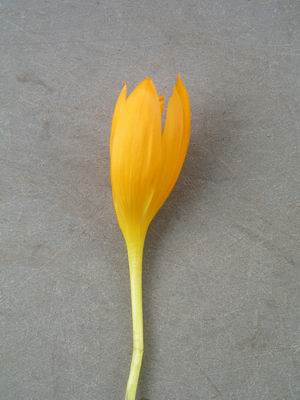 Crocus scharojanii The first of the summer Crocus to flower is this Crocus scharojanii. I found it lying, severed, on the pot in the bulb frame chewed off by a **^^^~~** slug, I had not even noticed it coming through. Crocus scharojanii is a rare species; we see much more of C.scharojanii flavus, which is probably a hybrid with vallicola. I sowed this seed in November 1996, it was wild collected, and this is the first flower I have had on it. I do not know if I have been growing it badly or if it is a slow to mature species, as we usually flower crocus from seed in three or four years at most.  Crocus seed I often do not find our own crocus seed until I am repotting as their pods are sometimes under the ground level. The seeds are fascinating and very variable - much like the corms are - I think my favourite seeds are the deep red velvety type like these. 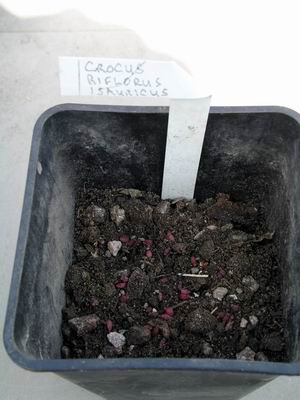 Crocus seed with bulb When I find some seed in this way I often sow it in with the corms. I just cover the corms so I cannot see them, with compost, then I sow the seed and then I fill the pot.  Narcissus 1st year seedlings If I only have a small amount of seed I often sow it in the same pot as the parent bulb - this saves me having to find space for yet another pot. These nice large narcissus seedlings are just one year old and were sown deeply in the pot with the parent bulb - they are twice as large as they would have been if sown on the surface. 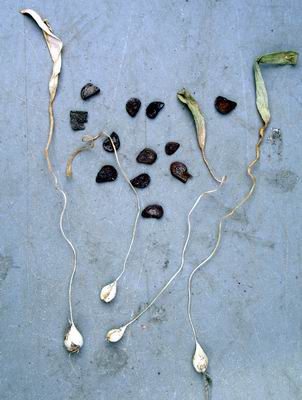 Frit stenanthera 2year seedlings Fritillaria seed must be surface sown; it does not germinate if sown deeply. This is a two year old pot of Frit stenanthera; you can see how they have evolved to place themselves at a suitable depth. It is very important to ensure they are at least at the same depth when you repot.  Fritillaria argolica You have to get to know your bulbs; these Fritillaria argolica bulbs are always this distinctive shape, slightly elongated, it is not a sign that they are trying to get deeper in this case.  Fritillaria kotschyana This form of Fritillaria kotschyana PW75-957 is unusual in having elongated offsets that are like short stolons. The other forms of Fritillaria kotschyana we grow have more normal small bulb-shaped offsets.  Frit hermonis amana bulb I spoke in the last log about the rice grains on Eurasian bulbs forming in the autumn on the old bulb. This can be seen in this picture; on the left you can see the faint remains of the old bulb with the rice grains attached, the white centre is the base of the old stem, and the roots are just visible below. On the right is the new bulb shown upside down with a hole through the centre where I have removed the old stem.  Fritillaria camschatensis x2 By contrast Fritillaria camschatensis is of the American type (although it also grows in Siberia and Japan) which produces the rice grains on the new bulb. It is one of the most interesting of the frit bulbs, close to a lily, it has some similarity with the Eurasian type but it is much closer to its North American cousins. 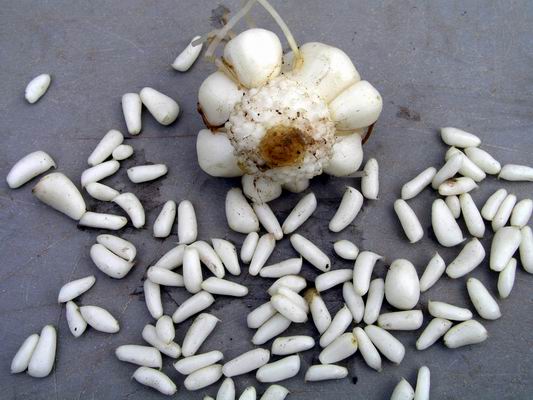 Fritillaria camschatensis rice This picture taken with the rice removed, to show the basal plate, reveals this affinity with the likes of Frit affinis bulbs. I suspect that the N American rice grain frits, typified by F. affinis, have evolved from Fritillaria camschatensis. 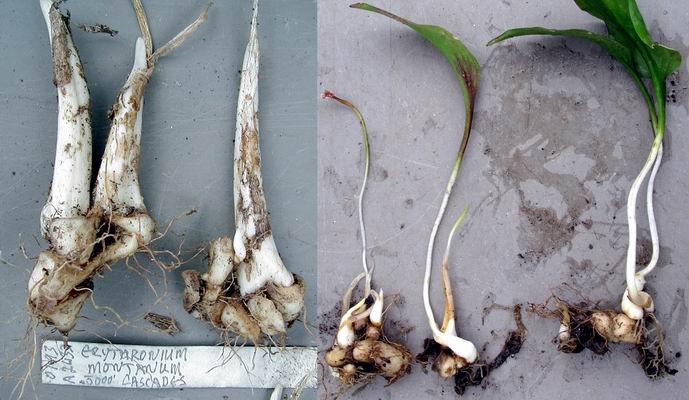 Erythronium montanum chain In log 29 I showed you the small linked remains of previous years bulbs on erythronium dens-canis, a 'chain', that I removed from the new bulb to see if it would produce new bulbs. Above left are Erythronium montanum bulbs which I removed from their chain which you can see still attached at the base. I potted the chain up this time last year and as you can see on the right it does produce new bulbs from dormant buds which would not grow as long as the main bulb is still attached. 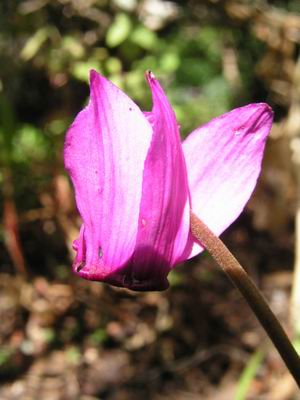 Cyclamen purpurascens A few flowers to end this log. Cyclamen purpurascens always the first cyclamen to flower for us, it opened two weeks ago.  Lilium martagon This is the first year flowering of this seed raised Lilium martagon which turns out to be the darkest form we have. Another good reason to raise bulbs from seed. ^ back to the top ^ |